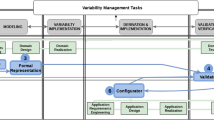Abstract
Verification of the domain engineering is motivated by two reasons: (1) the huge size of the software assets and (2) the possibility of changes in business rules or in stakeholders’ needs which affect the structure of the domain engineering. To solve this problem of verifying software product line (SPL), we propose set of rules to verify four operations: inconsistency detection, inconsistency prevention, dead feature detection, and false-optional feature detection. Scalability is a key factor in measuring the applicability of the methods dealing with the domain engineering. We generated experiments for testing the scalability of our approach. Our experiments results show that our approach is scalable.
Access this chapter
Tax calculation will be finalised at checkout
Purchases are for personal use only
Similar content being viewed by others
References
Benavides D, Ruiz-Cortés A, Batory D, Heymans P (2008) Opining introduction. In: First international workshop on analyses of software product lines (ASPL’08), Limerick
Benavides D, Metzger A, Eisenecker U (2009) Opining introduction. In: Third international workshop on variability modelling of software-intensive systems, ICB-research report No. 29, University of Duisburg Essen, Duisburg
Benavides D, Batory D, Grünbacher P (2010) Opining introduction. In: Fourth international workshop on variability modelling of software-intensive systems, ICB-research report No. 37, University of Duisburg Essen, Duisburg
Eisenecke U, Apel S, Gnesi S (2012) Opining introduction. In: Sixth international workshop on variability modelling of software-intensive systems, ACM, Leipzig
Heymans P, Czarnecki K, Eisenecker U (2011) Opining introduction. In: Fifth international workshop on variability modelling of software-intensive systems, Namur
Mannion M (2002) Using first-order logic for product line model validation. In: the second software product line conference SPLC2, San Diego
Lan Q, Liu S, Li B, ChenY, Pang S, Yin J (2006) Research on variability metamodeling method. In: The first international symposium on pervasive computing and applications (SPCA06), Urumchi
Batory D, Benavides D, Ruiz-Cortés A (2006) Automated analysis of feature models: challenges ahead. Commun ACM 49(12): 45–47
Massen T von der, Litcher H (2004) Deficiencies in feature models, workshop on software variability management for product derivation- towards tool support, collocated with SPLC 2004, Boston
Massen T von der, Litcher H (2005) Determining the variation degree of feature models. In: Software product lines conference, Lecturer notes in computer science, vol 3714. Rennes, pp 82–88
Czarnecki K, Eisenecker U (2002) Generative programming: methods, tools, and applications. Addison-Wesley, Boston
Elfaki A, Phon-Amnuaisuk S, Ho CK (2009) Modeling variability in software product line using first order logic. In: Proceedings of 7th the international conference on software engineering research, management and applications (SERA2009), Haikou
Kang K, Cohen S, Hess J, Novak W, Peterson S (1990) Feature oriented domain analysis (FODA) feasibility study, Technical report no. CMU/SEI-90-TR-21, Software Engineering Institute, Carnegie Mellon University, Pittsburgh
Pohl K, Böckle G, van der Linden F (2005) Software product line engineering foundations principles and techniques. Springer, Heidelberg
Czarnecki K, Kim C (2005) Cardinality-based feature modeling and constraints: a progress report. In: Proceedings of the international workshop on software factories at OOPSLA05, San Diego California
Benavides D, Segura S, Ruiz-Cort´es A (2010) Automated analysis of feature models 20 years later: a literature review. Inform Syst j 35(6), Elsevier: 615–636
Kasikci BC, Bilgen S (2009) Scalable modeling of software product line variability. In: 13th international software product line conference, SPLC 2009, San Francisco
Wang H, Li YF, Sun J, Zhang H, Pan J (2007) Verifying feature models using OWL. J Web Semantics 5(2):117–129, Elsevier
Trinidad P, Benavides D, Dur´an A,Ruiz-Cort´es A, Toro M (2008) Automated error analysis for the agilization of feature modeling. J Syst Softw 81(6): 883–896
White J, Dougherty B, Schmidt D, Benavides D (2009) Automated reasoning for multi-step feature model configuration problems. In: 13th international software product line conference table of contents San Francisco, California, pp 11–20
Hemakumar A (2008) Finding contradictions in feature models. In: First international workshop on analyses of software product lines (ASPL’08)’, collocated with SPLC08. Limerick
Trinidad P, Benavides D, Ruiz-Cort´es A (2006) Isolated features detection in feature models. In: Advanced information systems engineering, 18th international conference, CAiSE2006,short paper proceedings, Luxembourg
Trinidad P, Benavides D, Ruiz-Cort´es A (2006) Explanations for agile feature modeling. In the first workshop on agile product line engineering (APLE’06), Baltimore
Trinidad P, Ruiz Cort´es A (2009) Abductive reasoning and automated analysis of feature models: how are they connected? In: Third international workshop on variability modelling of software-intensive systems. Proceedings, pp 145–153
Thurimella AK, Janzen D (2011) on the metadoc feature modeler. In: SPLC2011 proceedings
Segura S (2008) Automated analysis of feature models using atomic sets. In: Proceedings of first international workshop on analyses of software product lines (ASPL’08)’, collocated with SPLC08, Limerick
Author information
Authors and Affiliations
Corresponding author
Editor information
Editors and Affiliations
Rights and permissions
Copyright information
© 2013 Springer-Verlag Berlin Heidelberg
About this chapter
Cite this chapter
Elfaki, A.O. (2013). Automated Verification of Variability Model Using First-Order Logic. In: Maalej, W., Thurimella, A. (eds) Managing Requirements Knowledge. Springer, Berlin, Heidelberg. https://doi.org/10.1007/978-3-642-34419-0_12
Download citation
DOI: https://doi.org/10.1007/978-3-642-34419-0_12
Published:
Publisher Name: Springer, Berlin, Heidelberg
Print ISBN: 978-3-642-34418-3
Online ISBN: 978-3-642-34419-0
eBook Packages: Computer ScienceComputer Science (R0)




